sierraclub.org - sierra magazine - january/february 2010 - bulletin | news for members


Bulletin | News for Members
By Della Watson
Grilled | Hot Fish, Blue Fish | Clean-Energy Counterpunch | DIY: Storm Drain Stencils | Love, Naturally
Grilled:
Invading the Privacy of the Volunteers Who Make the Club Tick
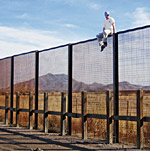 Name: Dan Millis
Name: Dan Millis
Location: Tucson, Arizona
Contribution: Sierra Club Borderlands Campaign organizer
Web site: sierraclub.org/borderlands
Why does the Sierra Club care about the border wall? We're talking about a 670-mile barrier, 630 miles of which have been built. Habitats have been fragmented; some have been lost altogether. It's created massive floods, major erosion, and sedimentation problems. People need to understand that we have endangered species down here--jaguars, bighorn sheep, and more.
Is habitat fragmentation the biggest problem? The biggest problem is the REAL ID Act [a 2005 bill that gives the Department of Homeland Security secretary discretion to waive environmental laws that impede the construction of border barriers]. All these bedrock laws that we've fought for, for decades, can now be ignored in the name of national security. It's something environmentalists absolutely should not tolerate.
How did you get involved? I was volunteering with a humanitarian group, No More Deaths, responding to Homeland Security's enforcement-only strategy at the border. They walled off the places where access was easy, basically funneling people into more remote and treacherous areas. That has negative environmental impacts--once-pristine habitats are getting trampled--but it also makes things much more dangerous for the people. I had the terrible experience of finding a dead body out in the desert, a 14-year-old girl from El Salvador.
How did she die? She was crossing with her 10-year-old brother. She became ill and fell behind. She told him she would be all right and encouraged him to keep going. He did, and he was reunited with their mother. But she didn't make it, and we found her three weeks later.
Have you encountered resistance? Two days after finding the body of that little girl, I was leaving water at our regular drop sites. I'm part of a team of volunteers who put out bottles of water and then come back weekly to pick up trash and leave more water. The law enforcement officers ticketed me for littering. I ended up being convicted for the so-called offense of providing water for people who might otherwise die.
How do you avoid feeling frustrated? There are small things that we do to help ourselves feel better and get through the day. When hiking at the front of a group of volunteers, for example, in my head I play a mildly entertaining and entirely self-explanatory game I call "stick or snake?" —interview by Della Watson
Go here to see a slide show of borderlands photos.
Do you know a Sierra Club volunteer who deserves recognition? Send nominations to submissions.sierra@sierraclub.org.
Hot Fish, Blue Fish, Pupfish, Dead Fish
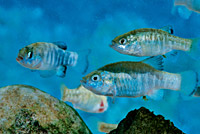 The Devil's Hole pupfish are nickel-size, iridescent blue, and found only in the 93-degree Fahrenheit geothermal waters of the cavern they're named after. And at press time, there were fewer than 150 of them left.
The Devil's Hole pupfish are nickel-size, iridescent blue, and found only in the 93-degree Fahrenheit geothermal waters of the cavern they're named after. And at press time, there were fewer than 150 of them left.
So Toiyabe Sierra Club Chapter members spent a weekend last year working to improve the species' habitat and that of its also-endangered cousin, the Ash Meadows Amargosa pupfish. Volunteers removed cattails and unauthorized trails at the Ash Meadows National Wildlife Refuge, about 90 miles west of Las Vegas.
Pupfish eat insects, aquatic invertebrates, and debris from native plants, but the 50,000 annual visitors to Ash Meadows have destroyed much of the surrounding fauna and flora. —Sarah F. Kessler
Clean-Energy Counterpunch
Las Vegas Sierra Club volunteers organized a speedy response to a protest against the American Clean Energy and Security Act in August. The chapter and other organizations that support the bill quickly assembled hundreds of counterprotesters outside the National Clean Energy Summit 2.0, held at the University of Nevada, Las Vegas. —Heather Moyer
DIY: Storm Drain Stencils
Spray It Like You Mean It
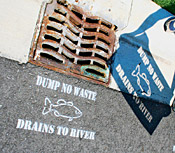 A "controlled graffiti project" is what Sierra Club organizer Italia Millan calls the spray-painted warnings she stencils on storm drains in southeastern Michigan. The words "Dump No Waste, Drains to River" now adorn almost 1,500 drains, thanks to members of the Club's Rochester ECOs, working in partnership with local public works departments and the county's drain commissioner.
A "controlled graffiti project" is what Sierra Club organizer Italia Millan calls the spray-painted warnings she stencils on storm drains in southeastern Michigan. The words "Dump No Waste, Drains to River" now adorn almost 1,500 drains, thanks to members of the Club's Rochester ECOs, working in partnership with local public works departments and the county's drain commissioner.
When these "taggers" go door-to-door to explain why they're spray-painting curbs in quiet neighborhoods, they find that many people are surprised to learn that pollutants dumped or washed into storm drains ultimately end up in local rivers and lakes. "One person told us his neighbor dumped antifreeze, and it went to the retention pond by their houses," Millan says. "They have ducks there, and the ducks died. They experienced firsthand the effects of dumping chemicals into our drains." —D.W.
Quick Tips
To get permission to stencil storm-drain warnings, contact the municipal agency responsible for maintaining your area's drainage system. Be sure to ask for a map pinpointing all local drains. And remember to bring a brush and a garbage bag to clear and collect trash.
ON THE WEB Watch the Club's storm-drain stenciling video at http://bit.ly/sdrain.
Love, Naturally
In honor of Valentine's Day, we asked three Sierra Club couples to share the details of their courtship. Here's
what we learned: A simple "Will you take my picture in front of this rock?" works as an icebreaker, but you'd better have solid camping cred if you want to seal the deal.
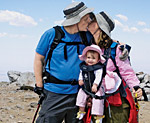 Jeff Wilson and Silvia Darie, Northridge, California
Jeff Wilson and Silvia Darie, Northridge, California
Jeff: I like taking pictures. She likes smiling in front of them. So that worked out really well.
Silvia: There's no better way to find somebody than to go on a rough-and-tumble trip where you see how they look when they're dirty, when they come out of a tent, and if they're grouchy after sleeping on hard ground all night.
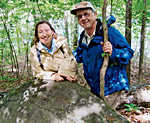 Larry Klaasen and Pat Klaasen, San Diego, California
Larry Klaasen and Pat Klaasen, San Diego, California
Larry: I had sort of half-noticed Pat at a Sierra Singles board meeting, and afterward she said, "You wanna go out for a beer?"
Pat: It was definitely interest at first sight.
Larry: I thought I did a reasonable amount of backpacking and stuff, but then she told me that in the previous year she'd been camping 95 days. I'm sitting there going, that's the equivalent of 50 weekends. Hmm.
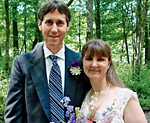 Joe Bina and Panaena Bina, Floyds Knobs, Indiana
Joe Bina and Panaena Bina, Floyds Knobs, Indiana
Joe: I first saw her in November 2004 at our annual meeting at Pine Mountain State Park in Kentucky. Nothing happened until our activists' weekend at Cumberland Lake in January.
Panaena: I was coming back from a hike, and Joe came out of the lodge and said that a woman had gotten lost and that people
were going out to search for her.
Joe: We started walking and just hollering out her name. We wandered off a little bit and probably got distracted somewhat.
Panaena: Luckily she was found. We did get to do some hiking in the snow, so it ended up being worthwhile.
ON THE WEB Join the Trail Twosomes group on Sierra Club Trails to share your nature-themed love story and enter the Valentine's Day photo contest.
Photos, from top: John Horrell, Stone Nature Photography/Alamy, iStockphoto/Ljupco, Italia Millan